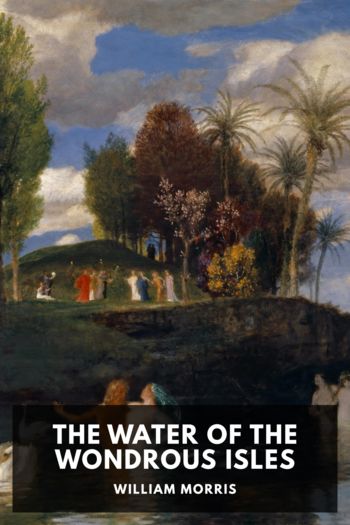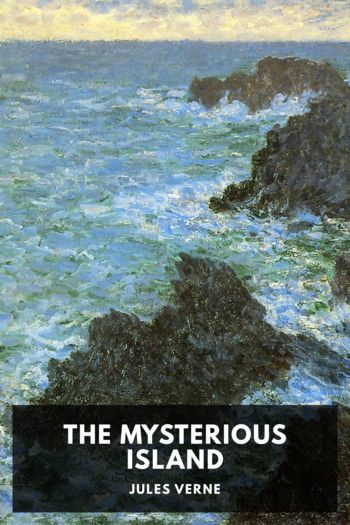An Antarctic Mystery, Jules Verne [ereader that reads to you TXT] 📗

- Author: Jules Verne
Book online «An Antarctic Mystery, Jules Verne [ereader that reads to you TXT] 📗». Author Jules Verne
After a short interval a shock was felt. The opposite hill fell down in a vast heap, burying William Guy and his twenty-eight companions.
Twenty-two of these unfortunate men were crushed to death on the instant, and their bodies would never be found under that mass of earth.
Seven, miraculously sheltered in the depth of a great cleft of the hill, had survived the catastrophe. These were William Guy, Patterson, Roberts, Coyin, Trinkle, also Forbes and Sexton, since dead. As for Tiger, they knew not whether he had perished in the landslip, or whether he had escaped. There existed in the right side of the hill, as well as in the left, on either side of the fissure, certain winding passages, and it was by crawling along these in the darkness that William Guy, Patterson, and the others reached a cavity which let in light and air in abundance. From this shelter they beheld the attack on the Jane by sixty pirogues, the defence made by the six men on board; the invasion of the ship by the savages, and finally the explosion which caused the death of a vast number of natives as well as the complete destruction of the ship.
Too-Wit and the Tsalal islanders were at first terrified by the effects of this explosion, but probably still more disappointed. Their instincts of pillage could not be gratified, because some valueless wreckage was all that remained of the ship and her cargo, and they had no reason to suppose that any of the crew had survived the cleverly contrived collapse of the hill. Hence it came about that Arthur Pym and Dirk Peters on the one side, and William Guy and his companions on the other, were enabled to remain undisturbed in the labyrinths of Klock-Klock, where they fed on the flesh of bitterns—these they could catch with their hands—and the fruit of the nut-trees which grow on the hillsides. They procured fire by rubbing pieces of soft against pieces of hard wood; there was a quantity of both within their reach.
After a whole week of this confinement, Arthur Pym and the half-breed had succeeded, as we know, in leaving their hiding-place, securing a boat, and abandoning Tsalal Island, but William Guy and his companions had not yet found an opportunity to escape.
After they had been shut up in the labyrinth for twenty-one days, the birds on which they lived began to fail them, and they recognized that their only means of escaping hunger—(they had not to fear thirst, for there was a spring of fresh water in the interior of the hill)—was to go down again to the coast, lay hands upon a native boat, and get out to sea. Where were the fugitives to go, and what was to become of them without provisions?—these were questions that had to be asked, and which nobody could answer. Nevertheless, they would not have hesitated to attempt the adventure if they could have a few hours of darkness; but, at that time of year, the sun did not as yet go down behind the horizon of the eighty-fourth parallel.
Death would probably have put an end to their misery had not the situation been changed by the following events.
On the 22nd of February, in the morning, William Guy and Patterson were talking together, in terrible perplexity of mind, at the orifice of the cavity that opened upon the country. They no longer knew how to provide for the wants of seven persons, who were then reduced to eating nuts only, and were suffering in consequence from severe pain in the head and stomach. They could see big turtles crawling on the beach, but how could they venture to go thither, with hundreds of natives coming and going about their several occupations, with their constant cry of tékéli-li?
Suddenly, this crowd of people became violently agitated. Men, women, and children ran wildly about on every side. Some of the savages even took to their boats as though a great danger were at hand. What was happening?
William Guy and his companions were very soon informed. The cause of the tumult was the appearance of an unknown animal, a terrible quadruped, which dashed into the midst of the islanders, snapping at and biting them indiscriminately, as it sprang at their throats with a hoarse growling.
And yet the infuriated animal was alone, and might easily have been killed by stones or arrows. Why then did a crowd of savages manifest such abject terror? Why did they take to flight? Why did they appear incapable of defending themselves against this one beast?
The animal was white, and the sight of it had produced the phenomenon previously observed, that inexplicable terror of whiteness common to all the natives of Tsalal.
To their extreme surprise, William Guy and his companions recognized the strange animal as the dog Tiger.
Yes! Tiger had escaped from the crumbling mass of the hill and betaken himself to the interior of the island, whence he had returned to Klock-Klock, to spread terror among the natives. But Tiger was no mere phantom foe; he was the most dangerous and deadly of enemies, for the poor animal was mad, and his fangs were fatal!
This was the reason why the greater part of the Tsalal islanders took to flight, headed by their chief, Too-Wit, and the Wampos, who are the leading personages of Klock-Klock. It was under these extraordinary circumstances that they abandoned their island, whither they were destined never to return.
Although the boats carried off the bulk of the population, a considerable number still remained on Tsalal, having no means of escape, and their fate accomplished itself quickly. Several natives who were bitten by Tiger developed hydrophobia rapidly, and attacked the others. Fearful scenes ensued, and are briefly to be summed up in one dismal statement. The bones we had seen in or





Comments (0)